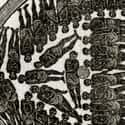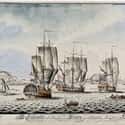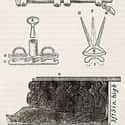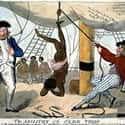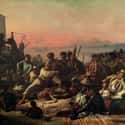-
(#5) Below Deck, The Odor From Feces, Urine, And Vomit Was Sickening
Olaudah Equiano described what met him when he went below deck:
I was soon put down under the decks, and there I received such a salutation in my nostrils as I had never experienced in my life: so that, with the loathsomeness of the stench and crying together, I became so sick and low that I was not able to eat. I now wished for the last friend, death, to relieve me.
Slaves were sometimes taken above deck and bathed, weather permitting, but the periodic washings were no match for the brutal conditions.
-
(#3) Captives Were Put Onto The Ships And Chained Below Deck
Once at the port city, slaves were marched onto ships and put below deck. Former slave Olaudah Equiano wrote about his experiences after being freed (he was active in the abolition movement in England in the 18th century) and described the confusion and shock he felt.
He wasn't sure if the white men were going to kill him or eat him. Once he was on board, he saw "a multitude of Black people of every description chained together, every one of their countenances expressing dejection and sorrow," and was so filled with fear that he fainted.
The chains used on the enslaved Africans would chafe and dig into their skin, making movement painful. With such a high death rate along the Middle Passage, many captives would find themselves fettered to corpses.
-
(#2) Captives Were Chained Together And Marched To The Boats
Captives from throughout Africa were brought together in port cities to be transported across the Atlantic Ocean. As they moved around from place to place on their journey toward the coast, the enslaved Africans would be chained to one another in slave trains. The people came from different backgrounds, spoke different languages, may have never seen the ocean before, and almost certainly had never been on a ship like the ones they were about to board.
-
(#11) If A Captive Refused To Eat, They Had Food Forced Down Their Throat
Keeping enslaved people alive was essential - and very difficult, given the conditions - so crew members did whatever it took to get them to eat. Their diet included bread, beans, and salted meat. If a person refused to eat, they were flogged, as much to punish them as to demonstrate to the other captives that resistance was not tolerated:
The man refused to eat. He had been sick, reduced to a ‘mere skeleton.’ He had apparently made a decision to die. Captain Timothy Tucker was outraged, and probably fearful that his example might spread to the other 200-plus captives aboard his ship, the Loyal George, as it made its way across the Atlantic to Barbados in the year 1727. The captain turned to his Black cabin boy, Robin, and commanded him to fetch his whip. This was no cat-o’-nine-tails but rather something much bigger, a horsewhip… All the while the man made no resistance and said nothing, which incensed the captain, who now threatened him in his own language: ‘He would tickeravoo him,’ that is, kill him, to which the man answered, ‘Adomma,’ so be it.
Crew members would also force-feed the slaves. They used a special piece of equipment called a "speculum oris, the long, thin mechanical contraption used to force open unwilling throats to receive gruel and hence sustenance."
-
(#10) Women Faced Their Own Terrible Conditions On The Ships
The majority of captives were men - they were deemed better for labor - but women were enslaved, as well. On the slave ships, men and women were kept apart from one another. Women and girls were often not kept in chains like their male counterparts. And on some ships, the captain slept in a hammock over the girls.
But women would often be sexually brutalized by the crew. John Newton tells a story of one of his crewmen assaulting a pregnant woman aboard his ship:
William Cooney seduced a woman slave down into the room and lay with her brutelike in view of the whole quarter deck, for which I put him in irons. l hope this has been the first affair of the kind on board and I am determined to keep them quiet if possible. If anything happens to the woman I shall impute it to him, for she was big with child.
-
(#8) Dysentery Was A Major Cause Of Death During The Eight-Week Voyage
The deplorable conditions on slave ships lent themselves to the spread of disease, particularly dysentery, AKA "the flux." In his accounts from his time at sea, slave merchant John Newton describes numerous captives dying due to "the flux," and the fear of outbreaks sweeping over the ship.
One former ship surgeon described the scene thus: "the deck, that is the floor of their rooms, was so covered with the blood and mucus which had proceeded from them in consequence of the flux, that it resembled a slaughterhouse."
Other diseases, including scurvy, influenza, measles, malaria, and smallpox, were also common on ships. With disease around every turn, the mortality rate on slave ships was as high as 15%.
New Random Displays Display All By Ranking
About This Tool
In August 1619, a Dutch ship carried 20 black slaves to Jamestown, the first colonial stronghold in Britain, which was the earliest black slave trade. The slaves were sent to several tobacco plantations along the coast, and the long history of slavery began. In the modern history of humans, the slave trade was the most shameful and despicable page.
From the Senegal estuary to the Congo estuary, there are slave ships of European colonial countries moored one after another. The jet-black bow of the ship is like an open blood basin that is waiting to devour human flesh. The random tool will help us to know 14 facts about the brutal life on slave ships.
Our data comes from Ranker, If you want to participate in the ranking of items displayed on this page, please click here.










